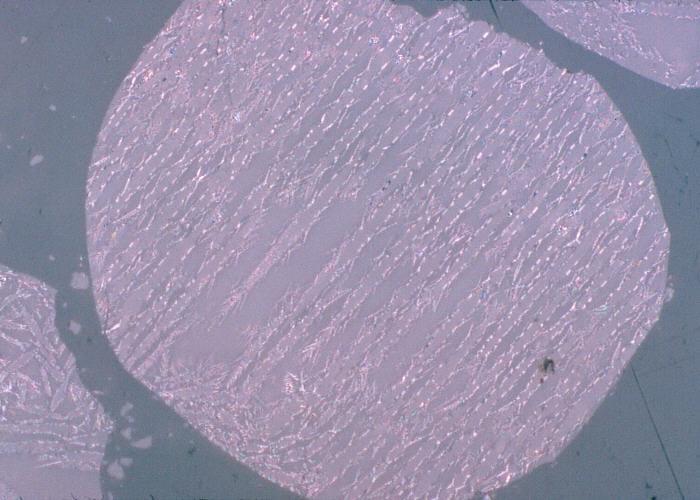
Sample 12002,320
Chromite occurs in this sample, suggesting it is one of the more primitive lavas. In the matrix, chromite is overgrown (partially replaced by?) ulvöspinel. In this image, the dark gray shades are silicates. The medium gray laths are ilmenite, the light gray in the center of grains is chromite, the pinkish-brown overgrowths on the chromite are ulvöspinel, the creamy brown bits are troilite, and the bright white grains are iron. Notice how the chromite grain embedded in olivine (right) is euhedral and not overgrown with ulvöspinel. Field width is 0.8 mm.

Sample 12002,320
Close-up of chromite in the image above, overgrown (partially replaced?) by ulvöspinel. Notice the large bright white native iron grain, and the small specks of iron in the triangular troilite grain in the lower right. Field width is 0.32 mm.

Sample 12005,39
This is a crystal of ulvöspinel (pinkish region). During cooling the grain has exsolved thin lamellae of ilmenite (brighter) and spinel (medium-gray). The adjacent olivine crystal is dark-gray. Field width is 0.32 mm.

Sample 12005,39
Trapped interstitial melt that quenched to a fine network of skeletal olivine and pyroxene (medium gray) and ilmenite (white). Darker gray regions are plagioclase and possibly other silica-rich minerals, and residual glass. Field width is 0.32 mm.

Sample 14305,176
Quenched glass fragment with lath-shaped dark-gray plagioclase, lighter-gray pyroxene, bright-white specks of iron, and tiny light-brown crystals of ilmenite. Much of the matrix of this breccia looks like the finer-grained matrix of this fragment. Field width is 0.8 mm.

Sample 70017,113
In the center is a rather large grain of troilite, with unmixed iron droplets. The pinkish-gray minerals to the left and right are ulvöspinel, containing ilmenite exsolution lamellae. Field width is 0.32 mm.

Sample 72275,508
Rapidly quenched liquid fragment with glass and feathery and radiating plagioclase and pyroxene crystals. Field width is 0.8 mm.

Sample 72275,508
Spongy iron grains possibly resulting from in situ reduction of silicate iron. Field width is 0.8 mm.

Sample 72275,508
Spongy iron grains possibly resulting from in situ reduction of silicate iron. Field width is 1.6 mm.

Sample 74220,355
This is an orange sphere in which numerous olivine blades nucleated and grew. In this image, the darkest gray material around the margins is epoxy. In the sphere, the darker gray material is glass, the lighter gray blades are olivine, and the bright white plates and specks are ilmenite. The parallel growth of the olivine blades in most samples is remarkable. Field width is 0.32 mm.
